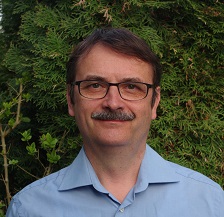Colloquium Announcement
Colloquium # 330
COMPLEX/DUSTY PLASMA PHYSICS – FROM LABORATORY TO SPACE
By
Prof. Hubertus M. Thomas
German Aerospace Center DLR,
Institute of Materials Physics in Space, 51147 Cologne, Germany
Friday, 19th Jan at 2:30 PM
|

Abstract
A dusty plasma is a plasma containing small solid particles in the range from nanometers to millimeters. Historically, dust in plasma was first observed by Langmuir in his pioneering work on plasma discharges in the 20ies of the last century. Nevertheless, dusty plasma research was concentrated on theoretical aspects of dust in space plasmas, like in cometary tails, Saturn rings, interstellar matter or star and planet forming clouds for a long time. Only in the late 1980ies laboratory research started since the plasma processing industry found the growth of dust particles in their production devices – a growth which diminished the efficiency of their processes. However, the biggest step in the dusty plasma research happened 30 years ago when in 1994 the Coulomb crystallisation of dust particles, charged in the plasma, – the so-called plasma crystal – was discovered. Starting with this, the research broadened from plasma physical aspects to classical condensed matter physics relying on the special properties of investigation of phenomena like melting or crystallisation, defect motion, or wave propagation in solids and liquids on the most fundamental - the individual particle level. Soon, it was recognized that strongly coupled dusty plasma is a new form of soft matter with many similarities to complex fluids. This was the reason to create the new field of “complex plasmas” to distinguish natural or by chance occurring dusty plasmas from plasmas were dust particles – in most cases monodisperse and spherical microparticles – were introduced on purpose. Due to the large mass of the microparticles gravity becomes the dominating force in the laboratory. To overcome this complementary research under microgravity conditions has been performed right from the beginning of the research, starting with parabolic flights and a sounding rocket in 1996, experiments on the Russian MIR Space Station in 1998 and followed by the long-term program on the International Space Station ISS from 2001 until now. The presentation will highlight the research on complex plasmas from the laboratory to space over the last 30 years and will discuss the future perspectives of the field.
About the Speaker
Hubertus M. Thomas is group leader at the DLR-Institute of Materials Physics in Space in Cologne, Germany. He received his Diploma in physics from the University of Cologne in 1992, and his Ph. D. degree from Ludwig-Maximilians Universität in Munich in 1996. He was working at the Max Planck Institute for extraterrestrial Physics in Garching from 1992 to 2013. His research interests are low temperature plasmas and especially complex/dusty plasmas, but also atmospheric pressure plasmas for application in hygiene and medicine. He was the responsible scientist for the long-term complex plasma projects PKE-Nefedov and PK-3 Plus, continuously operated on the International Space Station from 2001-2013 in a German-Russian program. He is the PI of the current facility PK-4 in the Columbus Module of the ISS operational since 2014. Beside the microgravity research a complementary program in the ground lab, in theory and simulation was performed in his group at DLR. Hubertus Thomas is author/co-author of more than 200 publications. In 2017 he received the Star Dust Award of the International Dusty Plasma Community

